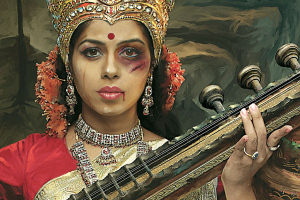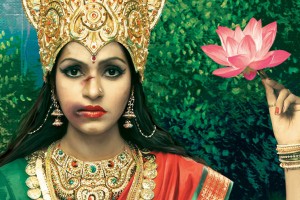Abused Goddesses, Orientalism and the Glamorization of Gender-Based Violence
By Sayantani DasGupta
 The Abused Goddesses of India. The advertisements, created by Mumbai-based ad firm Taproot India, have been making the rounds – not only of my Facebook friends’ walls, but of many a feminist and progressive site including Bust, Ultraviolet, V-Day and MediaWatch, usually along with reactions like “powerful” and “heartbreaking.”
The Abused Goddesses of India. The advertisements, created by Mumbai-based ad firm Taproot India, have been making the rounds – not only of my Facebook friends’ walls, but of many a feminist and progressive site including Bust, Ultraviolet, V-Day and MediaWatch, usually along with reactions like “powerful” and “heartbreaking.”
The images are unusual in their aesthetic appeal. After all, it’s not every day that you see the Hindu Goddesses Laxshmi, Saraswati or Durga made to appear as if they have been subject to gender-based violence – with tear stained faces, open cuts and battered cheekbones. But even despite (or because of?) the bruising around those divine eyes, the images are breathtaking – recreations of ancient Hindu paintings accurate to their last bejeweled crown and luscious lotus leaf.
I’ll admit it, I too was entranced by these ads when I first saw them. Having grown up in the heart of the American Midwest at a time when no one in the media looked even remotely like brown-skinned and dark haired me, I have a particular soft spot for images of glamorous Indian women. After childhood and teenage years believing that no one who wasn’t a blonde, blue-eyed Christie Brinkley look-alike could be deemed ‘beautiful,’ I’m still a complete sucker for images of traditional Indian beauty.
Yet, no matter how appealing, these ads are also deeply problematic. The reasons are multiple:
(1) Violence isn’t glamorous
The problem of glamorizing gender-based violence isn’t new. American popular culture is rife with images that glamorize violence against women and girls: from fashion spreads to music videos to television programs. Media critics like Jean Kilbourne have shown, time and again, how such media images create a cultural acceptance of violence – a rape culture– against women and girls in real life.
And so, despite the ostensible difference in message, the adoption of this sort of aesthetic point of view (of so-called ‘broken beauty’) by anti-violence campaigns is deeply troubling. In a recent workshop I conducted with Praxis International’s Advocacy Learning Center, I explored trends in some U.S., European, and Asian anti-violence campaigns. A predominant one is the graphic portrayal of passive, bruised and battered women’s images – made to somehow look simultaneously beautiful. Like fashion ads and music videos which glamorize violence, anti-violence ads – no matter where they are produced — also often border on the shock-vertising and voyeuristic, portraying images of morose and bruised women, women in the process of being abused or beaten, or even famous women re-enacting scenes of battering. The question is if such images might actually re-traumatize women who have experienced violence, while playing into the self-same patriarchal constructions of feminine passivity which enable such violence to happen in the first place.
(2) Female passivity/victimhood is too often valorized (and fetishized)
Part of the glamorization of violence in the media is our fascination with female victimhood, and this campaign is no different. Certainly, the name doesn’t help. Indeed, the ‘Abused Goddess’ posters are affiliated with the organization Save Our Sisters, a branch of Save the Children India. As one of the posters reads,
“Pray that we never see this day. Today, more than 68% of women in India are victims of domestic violence. Tomorrow, it seems like no woman shall be spared. Not even the ones we pray to.”
Um, really, folks? Whatever anyone’s personal spiritual beliefs may be, I really don’t think that prayer is a sufficient actionable solution to violence in and of itself – at least not for any progressive or feminist community. Forget ‘saving’ our sisters; how about ‘empowering’ our sisters, ‘standing with’ our sisters, or ‘watching out’ because our sisters are really angry and fed up of being victimized?
(3) Seeing suffering without a course of action kills empathy
Unlike the human rights organization Breakthrough’s Bell Bajao campaign, which suggests an on-the-ground action that can be taken by a bystander overhearing domestic violence in a neighbor’s home (to ring the bell, and bring on community censure), I’m not sure if there is any concrete action suggested by the Abuse Goddess campaign (beyond prayer). Rather, these images are sent into our cultural consciousness without an answer to the question, ‘what am I to do about this?’
Granted, there is a phone number for ‘reporting abuse’ to Save Our Sisters. Yet, what sort of abuse to report is unclear, as one of the posters mentions domestic violence and another trafficking, and the organization seems primarily an anti-trafficking group. What happens after this ‘reporting’ remains another question altogether. (For instance, police violence and community censure against women who report sexual or domestic abuse is not uncommon in many countries, including India)
Yet, despite the phone number, the ad doesn’t seem to be made with the actual women experiencing violence in mind. Rather, like many anti-violence campaigns, the Abused Goddesses series seems to be created in order to convince the ‘general public’ that violence against women and girls ‘really happens’. I’m not sure who this unbelieving general public is, precisely, but I’m not 100% convinced that ‘they’ need to be catered to. More importantly, appealing to ‘their’ sense of shock or outrage without giving them a concrete (and useful) avenue of action can actually be more dangerous than useful.
In her Regarding the Suffering of Others, Susan Sontag writes about the dangers posed by images of ‘distant suffering’:
Compassion is an unstable emotion. It needs to be translated into action, or it withers. The question of what to do with the feelings that have been aroused, the knowledge that has been communicated. If one feels that there is nothing ‘we’ can do — but who is that ‘we’? — and nothing ‘they’ can do either — and who are ‘they’ — then one starts to get bored, cynical, apathetic
(4) The images play into the idea that Indian/Brown women are particularly oppressed and in need of ‘saving’
 Despite being created by an Indian Ad Agency for an Indian audience, I’ve been particularly curious as to why these images have been so appealing to Western Feminists. The more I’ve thought about it, the more I’ve realized that the positive reactions to these posters by feminist and progressive sites in the U.S. might have more to do with Orientalism (‘ooo, brown goddesses!’) and a sisterhood of ‘saving’ than any position of global feminist solidarity.
Despite being created by an Indian Ad Agency for an Indian audience, I’ve been particularly curious as to why these images have been so appealing to Western Feminists. The more I’ve thought about it, the more I’ve realized that the positive reactions to these posters by feminist and progressive sites in the U.S. might have more to do with Orientalism (‘ooo, brown goddesses!’) and a sisterhood of ‘saving’ than any position of global feminist solidarity.
Indeed, it is a bit uncanny how well the Save Our Sisters campaign fits into Gayatri Chakravorty Spivak’s colonialist trope of ‘white men saving brown women from brown men’ (whereby this ‘saving’ becomes justification of everything from political paternalism to military invasion of the Global South by the Global North – consider that the wars in Iraq and Afghanistan have often been justified as missions to ‘save Muslim women from the veil.’). Only, in the case of Western feminists’ embracing of this advertisement – perhaps it’s a case of ‘white women saving brown women from brown men.’
The campaign plays right into Western audience’s assumptions about India, gender and violence – the idea that that gender-based violence is ‘so much worse’ in India. (A narrative which seem to be particularly in the American public consciousness today, consider this story written by an American student sexually harassed in India that made the social media rounds recently and this interesting response.) As buzzfeed so neatly puts it: “The campaign simply and effectively captures India’s most dangerous contradiction: that of revering women in religion and mythology, while the nation remains incredibly unsafe for its women citizens.”
Yes, gender-based violence is a real and important issue in India – as it is in the rest of the world. But assuming that it’s somehow a worse ‘contradiction’ in India because one of its major religions involves female divinities is forgetting the old ‘Goddess/Whore’ dichotomy that is the underpinning of many a patriarchal culture. In other words, simply because certain women or female figures may be deemed beloved or divine doesn’t mean that gender oppression and gender violence don’t exist. From Durga to The Virgin Mary to living and breathing movie stars or familial matriarchs, ‘goddesses’ are hardly unique to Hinduism, and neither is gender violence.
If anything, these images of Hindu goddesses looking sorrowful and downtrodden undermine culturally located sources of female power – however ‘contradictory’. These aren’t, for instance, images of the mother goddess Durga looking furious, riding her lion, and ripping apart her attacker with her trident and spear (which is how Durga is usually portrayed. It’s an image often used to characterize other mortal powerful women, why not women who are experiencing violence?). Nor are these goddesses banding together and organizing their own divine anti-violence empowerment organization (like a heavenly version of the pink sari brigade). Rather, we see the same old hackneyed images we see all over the world of victimized yet beautiful women; women isolated in their suffering and served up for the visual pity and pleasure of the viewing public (who are themselves somehow safe to click their tongues but then turn away and go about their busy lives).
Are mortal women benefitting?
In the end, what are these images accomplishing for real life Indian women facing violence? When an anti-violence advertisement ran in Britain featuring the goddess-like Keira Knightly getting beat up by an intimate partner, I found this response called “Battered: Hollywood Style” right on point. Not only do real women facing violence find celebrity (and/or divine?) portrayals unrelateable, but solely focusing on battered women rather than perpetrators can be deeply problematic. In the words of anti-violence advocate Denise Marshal, what if ‘Brad Pitt is shown beating up a woman, before turning to the camera and saying, ‘Any man can beat up a woman. We need to stop it’? (I’m not sure what I think of this suggestion – if it might not also glamorize abuse – but hey, if you’re out there reading The Feminist Wire, Brad Pitt, I’m very willing to discuss the issue with you.)
Whether of goddesses, celebrities, or models, images which glamorize gender-based violence may undermine the very cause they work for. By portraying bruised and battered goddesses as beautiful yet passive and in need of ‘saving’, these ads simply play into the same patriarchal narratives that allow gender-based violence to take place, as well as the same colonialist narratives that frame women of the Global South as needing, and welcoming, ‘rescue.’
We need new images with which to understand gender-based violence that don’t rely on these same problematic ‘victim’-based narratives that only deify, and fetishize, the category of the ‘passive female victim.’ We need new narratives so that feminists of the Global North can not only ‘understand’ but listen to, learn from, and collaborate with their sisters in the Global South. Because paternalism, Orientalism, and the glamorization of gender-based violence isn’t beautiful, whether in Heaven or right here on Earth.
_______________________________
 Originally trained in pediatrics and public health, Sayantani DasGupta, MD MPH teaches at the Master’s Program in Narrative Medicine at Columbia University and the Graduate Program in Health Advocacy at Sarah Lawrence College. She is Co-chair of the Columbia University Seminar on Narrative, Health and Social Justice and a faculty fellow at Columbia’s Center for the Study of Social Difference. Sayantani is the co-author of a book of Bengali folktales, the author of a memoir about her time at Johns Hopkins Medical School and co-editor of an award winning collection of women’s illness narratives, Stories of Illness and Healing: Women Write their Bodies. She is widely anthologized and published in venues including Ms., JAMA, Literary Mama, The Lancet and the recent Fifty Shades of Feminism (Little, Brown UK). Sayantani also writes for children and teens, and blogs for numerous online publications including Adios, Barbie, a pro-body image website. More about her work at www.sayantanidasgupta.com and http://storiesaregoodmedicine.
Originally trained in pediatrics and public health, Sayantani DasGupta, MD MPH teaches at the Master’s Program in Narrative Medicine at Columbia University and the Graduate Program in Health Advocacy at Sarah Lawrence College. She is Co-chair of the Columbia University Seminar on Narrative, Health and Social Justice and a faculty fellow at Columbia’s Center for the Study of Social Difference. Sayantani is the co-author of a book of Bengali folktales, the author of a memoir about her time at Johns Hopkins Medical School and co-editor of an award winning collection of women’s illness narratives, Stories of Illness and Healing: Women Write their Bodies. She is widely anthologized and published in venues including Ms., JAMA, Literary Mama, The Lancet and the recent Fifty Shades of Feminism (Little, Brown UK). Sayantani also writes for children and teens, and blogs for numerous online publications including Adios, Barbie, a pro-body image website. More about her work at www.sayantanidasgupta.com and http://storiesaregoodmedicine.

Pingback: Article Review 9.13.13. | it takes a nation of millions to hold us back
Pingback: The Roundup for September 19th, 2013
Pingback: Just another article about the Abused Goddesses Campaign
Pingback: Protesta Creativa – Diosas maltratadas